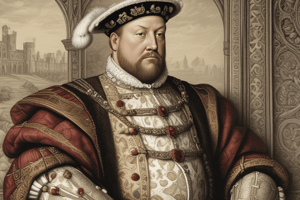Podcast
Questions and Answers
What was the War of the Roses?
What was the War of the Roses?
A dynastic conflict between the houses of York and Lancaster.
Who became king as Henry VII?
Who became king as Henry VII?
Henry Tudor
Who succeeded Henry VII to the throne?
Who succeeded Henry VII to the throne?
Henry VIII
Henry VIII successfully annulled his marriage with Catherine of Aragon through the Pope.
Henry VIII successfully annulled his marriage with Catherine of Aragon through the Pope.
Who was executed in the Tower of London in 1536?
Who was executed in the Tower of London in 1536?
What did the Act of Supremacy establish?
What did the Act of Supremacy establish?
What was the name of Henry VIII's only son to survive infancy?
What was the name of Henry VIII's only son to survive infancy?
What nickname was given to Mary, the daughter of Catherine of Aragon?
What nickname was given to Mary, the daughter of Catherine of Aragon?
What group did Protestants form upon returning to England after Mary's reign?
What group did Protestants form upon returning to England after Mary's reign?
Who succeeded Queen Mary in 1558?
Who succeeded Queen Mary in 1558?
Why was Elizabeth I known as 'The Virgin Queen'?
Why was Elizabeth I known as 'The Virgin Queen'?
What was the nature of the threat posed by Mary Queen of Scots?
What was the nature of the threat posed by Mary Queen of Scots?
What colony did Sir Walter Raleigh establish in 1584?
What colony did Sir Walter Raleigh establish in 1584?
Match the main sonneteers of the Elizabethan Age with their names:
Match the main sonneteers of the Elizabethan Age with their names:
What is the most common poetic form of the Elizabethan literature?
What is the most common poetic form of the Elizabethan literature?
Flashcards are hidden until you start studying
Study Notes
The War of the Roses
- A dynastic conflict between the Houses of York and Lancaster.
- The conflict ended with the Battle of Bosworth Field in 1485.
- Richard of York, symbolized by a white rose, was defeated and killed by Henry Tudor of the House of Lancaster, symbolized by a red rose.
- Henry's victory marked the beginning of the Tudor era in England.
Henry VII
- Became king as Henry VII after the Battle of Bosworth Field.
- Married Elizabeth of York to unite the feuding families of York and Lancaster.
Henry VIII
- Succeeded his father, Henry VII to the throne.
- Married Catherine of Aragon and had a daughter, Mary.
- Attempted to annul his marriage to Catherine of Aragon, but the Pope refused.
- Secreted married Anne Boleyn after the Pope's refusal, who gave birth to Elizabeth.
- The annulment and marriage to Anne Boleyn led to the break with Rome.
The Act of Supremacy
- Confirmed Henry VIII as the supreme head of the Church of England in 1534.
- Separated the Church of England from the Roman Catholic Church.
- Henry suppressed religious orders and confiscated their property.
Succession Guaranteed
- Henry VIII's second wife, Anne Boleyn, gave birth to Elizabeth.
- Henry accused Anne of adultery, incest, and treason.
- Anne was executed in the Tower of London in 1536.
- Henry VIII married Jane Seymour, who bore his only male heir, Edward.
The Short Reign of Edward VI
- Henry VIII was succeeded by his son, Edward VI, at the age of nine.
- Edward VI died in 1553.
Bloody Mary
- Mary, daughter of Catherine of Aragon, was proclaimed queen in 1553.
- A devout Catholic, Mary attempted to restore Roman Catholicism to England.
- Mary's persecution of Protestants earned her the nickname "Bloody Mary".
The Puritans
- Mary's persecution caused a shift in religious thought.
- Protestants fled to Protestant cities like Geneva and Basel, influenced by John Calvin.
- These Protestants formed a Calvinistic group known as the Puritans.
- Puritans wanted to purify the Church of England and remove all traces of Roman Catholic practices.
Elizabeth I
- Succeeded her half-sister, Mary, in 1558.
- Promoted the Second Act of Supremacy, re-establishing the Anglican Church.
- Elizabeth's approach to reform was known as the "middle way" due to its balanced approach between Protestantism and Catholicism.
Foreign Policy
- Elizabeth I was known as the "Virgin Queen".
- Elizabeth received many marriage proposals, including from Philip II of Spain.
- She refused all proposals to avoid offending either Protestants or Catholics and to maintain her country's independence.
A Formidable Rival, Mary Queen of Scots
- Mary Stuart claimed the throne of England due to her descent from Henry VII.
- Mary became Queen of Scotland and, after facing challenges, fled to England seeking the protection of Elizabeth.
- Mary's claim to the throne presented a threat to Elizabeth's rule.
- Elizabeth eventually ordered Mary's execution in 1587.
Trade and Empire
- Sir Walter Raleigh established a colony on the east coast of North America in 1584.
- The colony was named "Virginia" in honor of Queen Elizabeth.
- Raleigh's act marked the beginning of a period of British imperial expansion.
England and Spain
- Queen Elizabeth's refusal to marry Philip II of Spain strained relations between England and Spain.
- Elizabeth's support for Protestant rebellions in the Netherlands aggravated relations.
- Spain saw England as a threat to its dominance in the New World.
- The Spanish Armada, a Spanish naval expedition aimed at invading England, was defeated in 1588, marking a major victory for England.
The Golden Age of Drama
- The English Renaissance was a golden age for English literature.
- Drama and poetry, particularly sonnets, flourished.
- The sonnet, a 14-line poetic composition, was popularized by Italian poet Petrarch.
- Philip Sidney, Edmund Spenser, and William Shakespeare were key figures in the Elizabethan era.
Studying That Suits You
Use AI to generate personalized quizzes and flashcards to suit your learning preferences.




